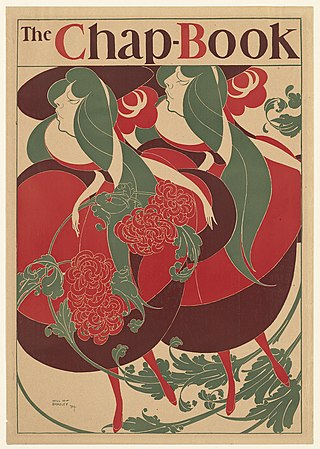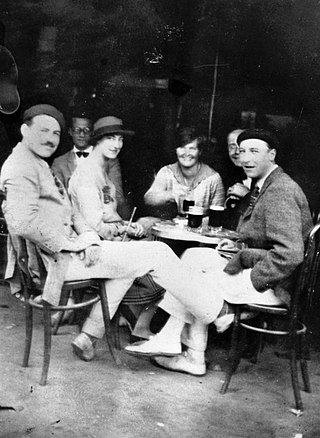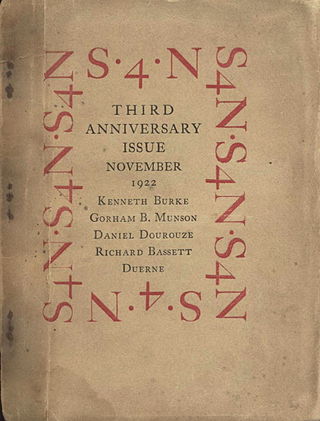
Lola Ridge was an Irish-born New Zealand-American anarchist and modernist poet, and an influential editor of avant-garde, feminist, and Marxist publications. She is best known for her long poems and poetic sequences, published in numerous magazines and collected in five books of poetry.

transition was an experimental literary journal that featured surrealist, expressionist, and Dada art and artists. It was founded in 1927 by Maria McDonald and her husband Eugene Jolas and published in Paris. They were later assisted by editors Elliot Paul, Robert Sage, and James Johnson Sweeney. After the Second World War, the publishing license of transition was transferred from the Jolases and McDonald to Georges Duthuit who capitalized the title to Transition and changed its focus.

In the United States, a little magazine is a magazine genre consisting of "artistic work which for reasons of commercial expediency is not acceptable to the money-minded periodicals or presses", according to a 1942 study by Frederick J. Hoffman, a professor of English. While George Plimpton disagreed with the diminutive connotations of "little", the name "little magazine" is widely accepted for such magazines. A little magazine is not necessarily a literary magazine, because while the majority of such magazines are literary in nature, containing poetry and fiction, a significant proportion of such magazines are not. Some have encompassed the full range of the arts, and others have grown from zine roots.

Others: A Magazine of the New Verse was an American literary magazine founded by Alfred Kreymborg in July 1915 with financing from Walter Conrad Arensberg. The magazine ran until July, 1919. It was based in New York City and published poetry and other writing, as well as visual art. While the magazine never had more than 300 subscribers, it helped launch the careers of several important American modernist poets. Contributors included: William Carlos Williams, Orrick Johns, Wallace Stevens, Marianne Moore, Mina Loy, Ezra Pound, Conrad Aiken, Carl Sandburg, T. S. Eliot, Amy Lowell, H.D., Djuna Barnes, Man Ray, Skipwith Cannell, Lola Ridge, Marcel Duchamp, and Fenton Johnson (poet).
The Dial was an American magazine published intermittently from 1840 to 1929. In its first form, from 1840 to 1844, it served as the chief publication of the Transcendentalists. From the 1880s to 1919 it was revived as a political review and literary criticism magazine. From 1920 to 1929 it was an influential outlet for modernist literature in English. In January 2023, The Dial was revived once again as a magazine of international writing and reporting.
Robert Myron Coates was an American novelist, short story writer and art critic. He published five novels; one classic historical work, The Outlaw Years (1930) which deals with the history of the land pirates of the Natchez Trace; a book of memoirs, The View from Here (1960), and two travel books, Beyond the Alps (1962) and South of Rome (1965). During his unusually varied career, Coates explored many different genres and styles of writing and produced three highly remarkable experimental novels, The Eater of Darkness (1926), Yesterday’s Burdens (1933) and The Bitter Season (1946). Highly original and experimental, these novels draw upon expressionism, Dadaism and surrealism. His last two novels—Wisteria Cottage (1948) and The Farther Shore (1955)—are examples of crime fiction. Simultaneously to working as a novelist, Coates maintained a life-long career at the New Yorker, whose staff he joined in 1927. The magazine printed more than a hundred of his short stories many of which were collected in three anthologies; All the Year Round (1943), The Hour after Westerly (1957) and The Man Just ahead of You (1964). Also, from 1937 to 1967, Coates was the New Yorker’s art critic and coined the term “abstract expressionism” in 1946 in reference to the works of Hans Hofmann, Arshile Gorky, Jackson Pollock and Willem de Kooning and others. He was elected to the National Institute of Arts and Letters in 1958. Coates was married to sculptor Elsa Kirpal from 1927 to 1946. Their first and only child, Anthony Robertson Coates, was born on March 4, 1934. In 1946, they divorced and Coates married short story writer Astrid Meighan-Peters. He died of cancer of the throat in New York City on February 8, 1973.

Aperture magazine, based in New York City, is an international quarterly journal specializing in photography. Founded in 1952, Aperture magazine is the flagship publication of Aperture Foundation.
The Little Review was an American avant-garde literary magazine founded by Margaret Anderson in Chicago's historic Fine Arts Building, published literary and art work from 1914 to May 1929. With the help of Jane Heap and Ezra Pound, Anderson created a magazine that featured a wide variety of transatlantic modernists and cultivated many early examples of experimental writing and art. Many contributors were American, British, Irish, and French. In addition to publishing a variety of international literature, The Little Review printed early examples of surrealist artwork and Dadaism. The magazine's most well known work was the serialization of James Joyce's Ulysses.

Harold Albert Loeb was an American writer, notable as an important American figure in the arts among expatriates in Paris in the 1920s. In 1921 he was the founding editor of Broom, an international literary and art magazine, which was first published in New York City before he moved the venture to Europe. Loeb published two novels while living in Paris in the 1920s, and additional works after returning to New York in 1929.

Alfred Francis Kreymborg was an American poet, novelist, playwright, literary editor and anthologist.
Marjorie Content (1895–1984) was an American photographer from New York City active in modernist social and artistic circles. Her photographs were rarely published and never exhibited in her lifetime. Since the late 20th century, collectors and art historians have taken renewed interest in her work. Her photographs have been collected by the Metropolitan Museum of Art and the Chrysler Museum of Art; her work has been the subject of several solo exhibitions.

The Glebe was a literary magazine edited by Alfred Kreymborg and Man Ray from 1913 to 1914. The first issue was published from Grantwood, New Jersey while the rest of the run was published in New York by Albert & Charles Boni. Ten issues were produced, with a circulation of 300. Issue number 5 comprised the first anthology of Imagism: Des Imagistes.
Matthew Josephson was an American journalist and author of works on nineteenth-century French literature and American political and business history of the late 19th and early 20th centuries. Josephson popularized the term "robber baron".
Allen Norton (1878?-1945?) was an American poet and literary editor of the 1910s and 20s. His father, E.L. Norton, was a stock broker. He went to Harvard, where he specialized in literature and began writing poetry. He and his wife Louise Norton edited the little magazine Rogue, published from March 1915 to December 1916. The periodical, partly financed by Walter Conrad Arensberg, served as an early showcase for the work of Arensberg himself, Wallace Stevens, Mina Loy, and Alfred Kreymborg. Norton's 1914 volume of verse, Saloon Sonnets With Sunday Flutings, was published by Donald Evan's Claire Marie Press. Heavily influenced by fin-de-siècle aestheticism, Alice Corbin Henderson remarked that his work, along with the poetry of Evans himself, represented something of a revival of that style. Poems in the volume included Impressions of Oscar Wilde, Modern Love and Mrs. Eddy: a Mask.
The Seven Arts, an early example of the little magazine, was edited by James Oppenheim, Waldo Frank, and Van Wyck Brooks; it appeared monthly from November 1916 through October 1917. Jointly envisaged by Oppenheim and Frank, The Seven Arts was an attempt to anticipate and influence the United States' emerging “renascent period;” in the first issue the editors explain: “In short, The Seven Arts is not a magazine for artists, but an expression of artists for the community.” Of the many contributors to the magazine, Sherwood Anderson, J. D. Beresford, Randolph Bourne, Theodore Dreiser, Robert Frost, Kahlil Gibran, D. H. Lawrence, Amy Lowell, Paul Rosenfeld, and Louis Untermeyer were among the most prolific.
Marshall Robert Loeb was an American author, editor, commentator and columnist specializing in business matters, who spent 38 years in the Time Inc. publication network which included service as managing editor of both Fortune and Money magazines. The New York Times called him "one of the most visible and influential editors in the magazine industry".

The New Hampshire Union Leader is a daily newspaper from Manchester, the largest city in the U.S. state of New Hampshire. On Saturdays, it publishes as the New Hampshire Sunday News.
Secession was an American expatriate little magazine edited by Gorham Munson, Matthew Josephson, and Kenneth Burke. During its two-year, eight issue run, Secession managed to further the careers of writers like Waldo Frank, Slater Brown, Robert Coates, E. E. Cummings, Marianne Moore, Wallace Stevens, Hart Crane, and William Carlos Williams, among others. Printed in cities like Vienna, Berlin, Reutte, and Brooklyn, New York, Secession is considered an exile magazine, and has been called the “liveliest” of the little magazines published abroad. In his article “The Interstice between Scylla and Charybdis,” Munson distinguished Secession from little magazines like The Little Review and Broom, and stated that the goal for his magazine is to be “neither a personal nor an anthological magazine, but to be a group organ. [Secession] will make group-exclusions, found itself on a group basis, point itself in a group-direction, and derive its stability and correctiveness from a group.” The pieces published in this magazine certainly demonstrated creative energy, but the strained relationship between Secession’s editors also contributed to the magazine's spirited image.

S4N was an American "little magazine" that was published from 1919–1925 in Northampton, Massachusetts. In its earliest stages, editor-in-chief Norman Fitts described the magazine as a "discussion of the arts in a monthly magazine". The magazine published contemporary poetry and stories, as well as essays discussing the direction of Modernism in art and music. Among the notable poets, writers and literary theorists that were published in the magazine were Elsa Gidlow, E.E. Cummings, Hart Crane, Kenneth Burke, and Malcolm Cowley. In The Little Magazine: A History and Bibliography, Frederick J. Hoffman's authoritative work on little magazines, contends that S4N, along with Broom, Secession, and Seven Arts, were trend-setters and leaders of innovation.
Martha Neill Upton was a watercolorist, sculptor and studio quilt artist. Her quilted tapestries helped quilts become seen as fine art, rather than craft work, during the early 1970s. Her quilts were shown in the first major museum exhibition of non-traditional quilts, The New American Quilt at New York's Museum of Arts and Design, then called the Museum of Contemporary Craft, in 1976.










